When many people think of mountain biking, they picture steep descents, technical jumps, and fearless riders in full-body armour. And while that side of the sport exists, there’s a whole other world of mountain biking that’s fun, accessible, and perfect for families and beginners.
At Scot Mountain Holidays, we’re all about helping people connect with the outdoors in ways that feel achievable and enjoyable. And yes — that includes mountain biking!
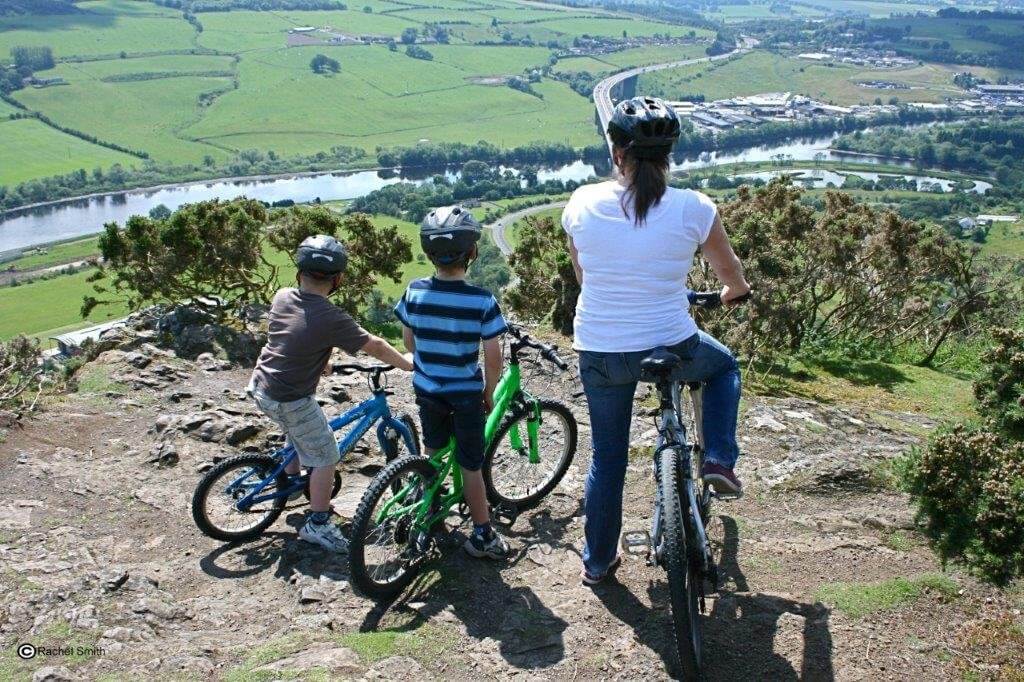
Mountain biking doesn’t have to mean hurtling down black-graded trails. In fact, most of the routes we recommend (and ride ourselves!) are gentle forest tracks, purpose-built family-friendly trails, and scenic off-road paths where the focus is on fun, not fear.
Our local area — the Cairngorms National Park — is home to some of the best beginner-friendly biking in Scotland. You’ll find peaceful woodland trails, lochside tracks, and even wildlife watching opportunities, all from the saddle.
There’s something incredibly bonding about exploring on two wheels. You cover more ground than walking, but you still get to experience the landscape up close — spotting red squirrels, stopping for picnics, and taking in the views. It’s an adventure that the whole family can share, regardless of age or ability.
We’ve hosted families with young kids who’ve taken to the trails with huge grins — and plenty of snack stops! We also cater to older kids and teens looking for a bit more challenge, with options to extend routes or tackle slightly more technical trails at their own pace.
Don’t have bikes? No problem. We can help arrange bike hire, including e-bikes if you want a little help up the hills. Not sure where to ride? We’ll give you route recommendations tailored to your ability and interests — whether it’s a gentle loop from our door or a full-day off-road adventure.
If you’re brand new to biking or want to brush up on your skills, we can even arrange introductory sessions to build confidence and technique in a relaxed, supportive environment.
Our home base, Fraoch Lodge, is perfectly placed for mountain biking, with trails accessible right from the door. After a day of pedalling, you can look forward to comfortable accommodation, hearty home-cooked meals, and a warm welcome back at the lodge. It’s the ideal setting for an active yet relaxing family break.
Whether you’re 7 or 70, you can enjoy mountain biking — and you don’t have to be fearless or ultra-fit to give it a go. All you need is a sense of curiosity and a willingness to try something new.
So if you’ve ever looked at a mountain bike and thought, “That’s not for me” — we invite you to think again. You might just discover your new favourite way to explore the Highlands.

Road cycling and mountain biking in the Cairngorms are increasingly popular
Ready to ride?
Check out our family-friendly activity holidays or get in touch to plan a bespoke biking break in the Cairngorms.
👉 scotmountainholidays.com
📞 01479 831 331
Mountain biking. Less scary than you think. Way more fun than you expect.
You’re being lied to about mountain biking
In this video I will be talking about some misconceptions when It comes to mountain biking and how all the expensive bikes and difficult trails are not what mountain biking is all about.
Walking is an excellent form of exercise, but you can really reap its benefits by ensuring you are eating the right foods for your workout. The key to your walking diet is to eat little and often. If you eat too much, you run the risk of feeling sluggish and not wanting to go any further, but eating too little can be equally dangerous as you need to keep your energy levels up when walking
Your walking diet isn’t just about what you eat while you’re on your walk. Eating the right foods before and after your walk is also important.
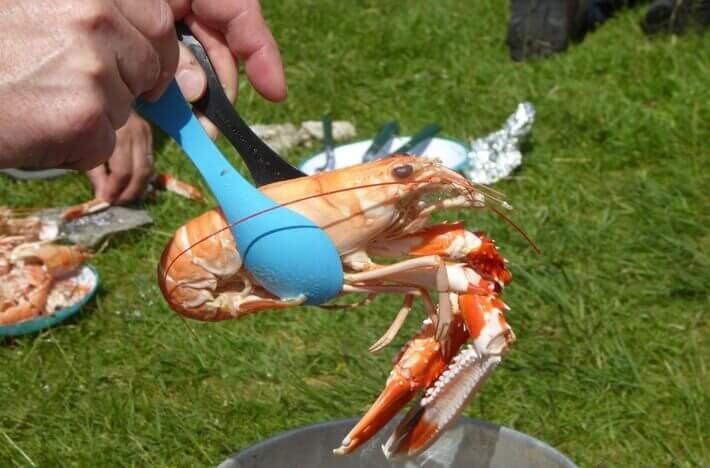
Water helps flush our systems of waste products and toxins, yet many people go through life dehydrated – causing tiredness, low energy, and headaches. It’s common to mistake thirst for hunger, so staying well hydrated may also help you make healthier food choices.
Find a physical activity that you like to do and add it to your day, even if it’s just small changes like taking the stairs instead of the lift or walking for 20 minutes in your lunch break. The benefits of exercise are abundant and regular activity may even help motivate you to eat more healthily.
The amount you need to eat depends on how far you are walking, your age, weight and general fitness levels.
Keeping hydrated is extremely important when walking. Make sure you carry plenty of water with you. You may also want to take some energy drinks with you to replace the salt you lose through sweating, but try to avoid drinks that have many additives. You can even make your own sports drink by mixing sugar and salt with water and some flavouring.
Some studies have shown that a short walk before breakfast is good for those who want to lose weight, but many people find they feel better if they have eaten. If you are going on a walk for more than 45 minutes, it’s very important that you eat a healthy breakfast before you set off.
A light breakfast that releases energy slowly is best, and this can include porridge or yoghurt with banana and other fruits. Everyone is different, so experiment with what works well for you and try to leave at least an hour before you set off on your walk.
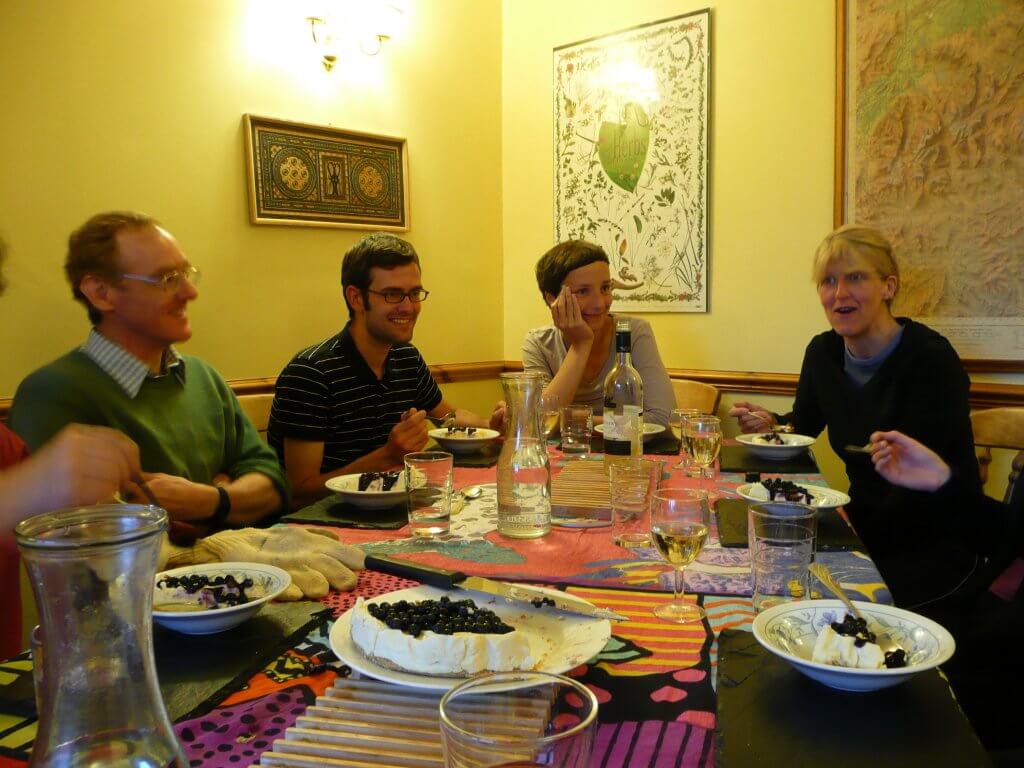
Make sure you take plenty of snacks with you to maintain your energy levels throughout your walk. This can include fruit such as:
Nuts and seeds such as:
If you are going to sit down and have a rest and some lunch, go for some of the snacks above plus a food high in carbohydrates and protein. Opt for wholemeal versions of pasta, rice or bread where possible, as these are better for you. You might want to take a wrap or sandwich filled with healthy fillings such as cottage cheese and salad, fish, or lean, white meats such as chicken or turkey.
We make all the bread at Fraoch Lodge. More often than not we use a seeded granary recipe which always goes down well and is extremely nutritious. Some clients opt for alternatives or supplement their sandwiches with our homemade egg muffins, quiche or pasties.
If you have walked for two hours or more, you’ll need carbohydrates and protein to help replenish your muscles. You could try a recovery drink, or make your own smoothie out of yoghurt or milk, fruit and honey. Or, have a snack combining both carbs and protein such as a bagel or oatcakes with peanut butter or low-fat cheese.
We always have cake o’clock back at Fraoch Lodge and have started to include some savoury choices too such as oatcakes, cheese and olives as not everyone is keen on the sugar hit from our bakes.
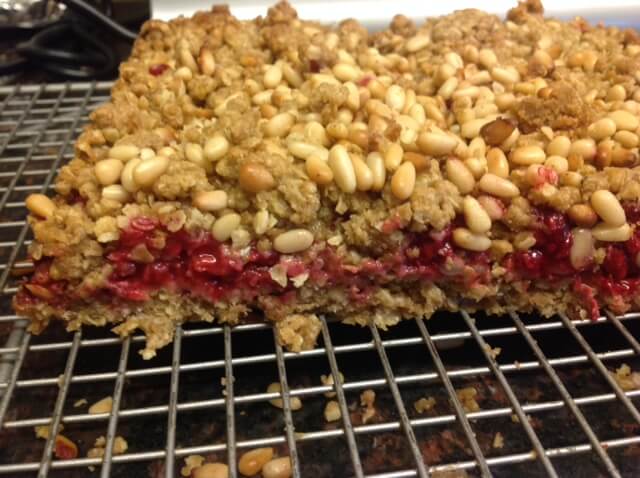
Raspberry and pine nut bars ready to be cut up for packed lunch or tea cakes
In today’s fast-paced world, we are constantly bombarded by negativity, confined within office walls, and often motivated by little more than financial gain. At the same time, we watch others experience more, travel more, and seemingly live more. Despite saying “I’m fine,” many of us feel that something is missing. So, how do we restore balance and wellness in our lives?
Our early ancestors lived much simpler lives, focused on survival—finding food, managing the weather, and protecting their territories. Despite their challenges, they thrived by working alongside nature. Today, though we still innovate and create, our setting has drastically changed. The natural world that once sustained us is now hidden behind high-rise buildings, leaving many disconnected from the great outdoors.
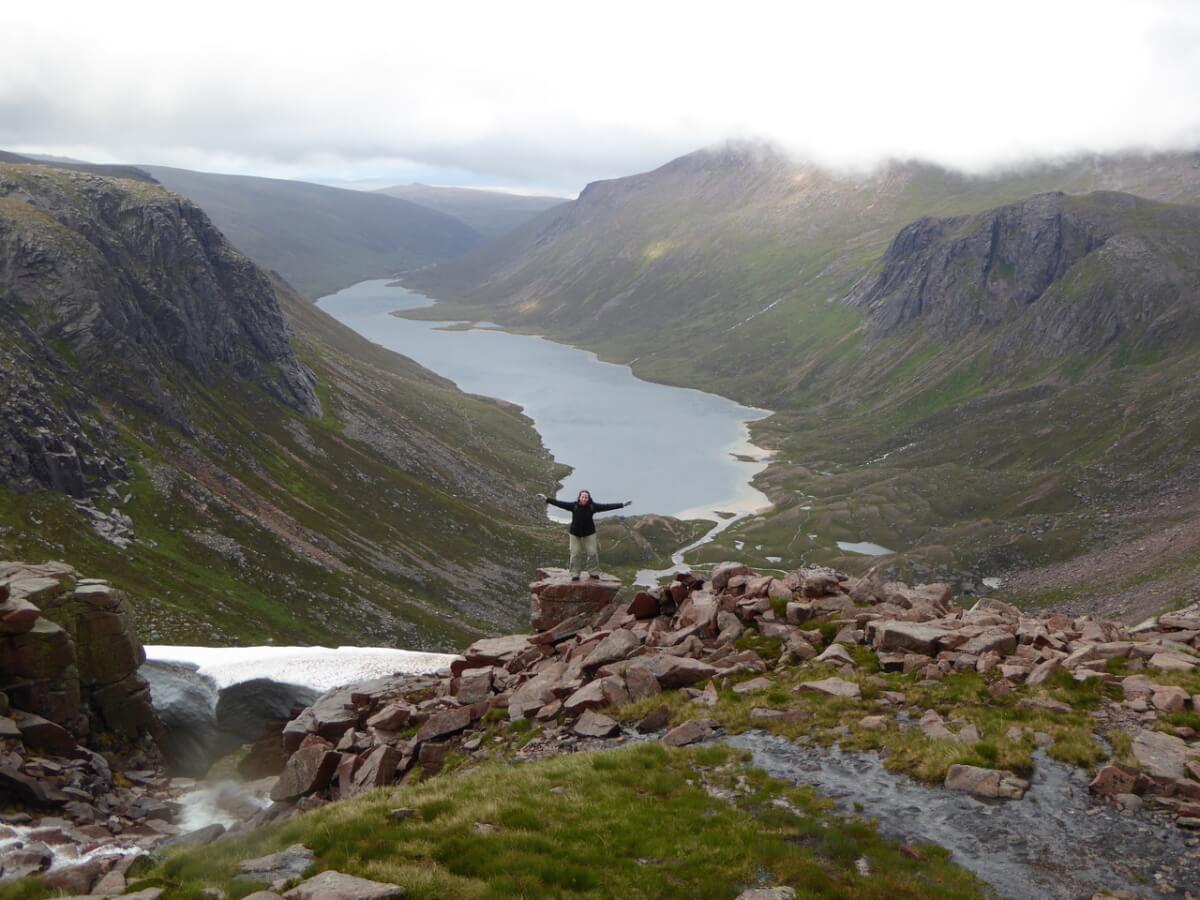
Posing amid the grandeur of the Cairngorms scenery
A psychologist friend of mine often speaks about “wild therapy,” a practice that encourages people to step outside their usual indoor routines and engage with nature. Our ancestors’ daily lives required them to move, explore, and adapt. Today, we must make a conscious effort to do the same. Even a simple walk can make a world of difference.
“Walking holidays are a great way to discover new areas of the UK countryside,” says Matt Fox, CEO of Snaptrip.com. “It’s also a brilliant way to remove yourself from the stress of daily life and come home feeling rejuvenated.” Walking is one of the easiest and most effective ways to maintain both physical and mental well-being.
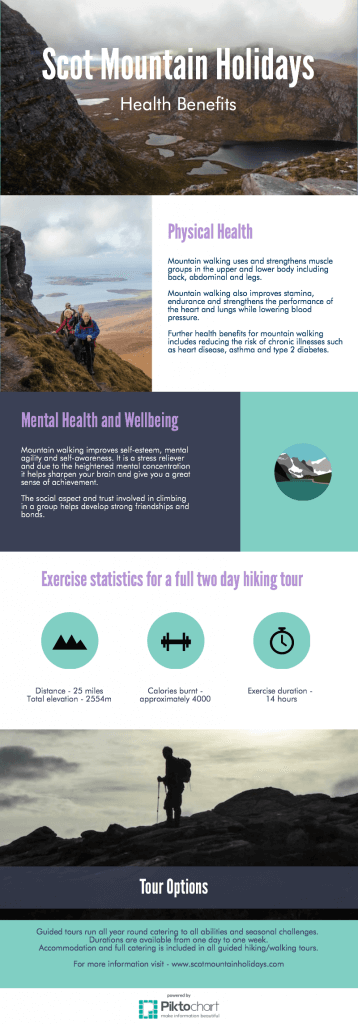
Walking in nature releases dopamine and serotonin—chemicals in the brain responsible for happiness and well-being. These neurotransmitters help reduce stress, anxiety, and even depression.
Humans evolved in tribal communities, and we have an innate need to connect with others. Walking introduces opportunities to meet new people, share experiences, and engage in positive interactions that boost mental health.
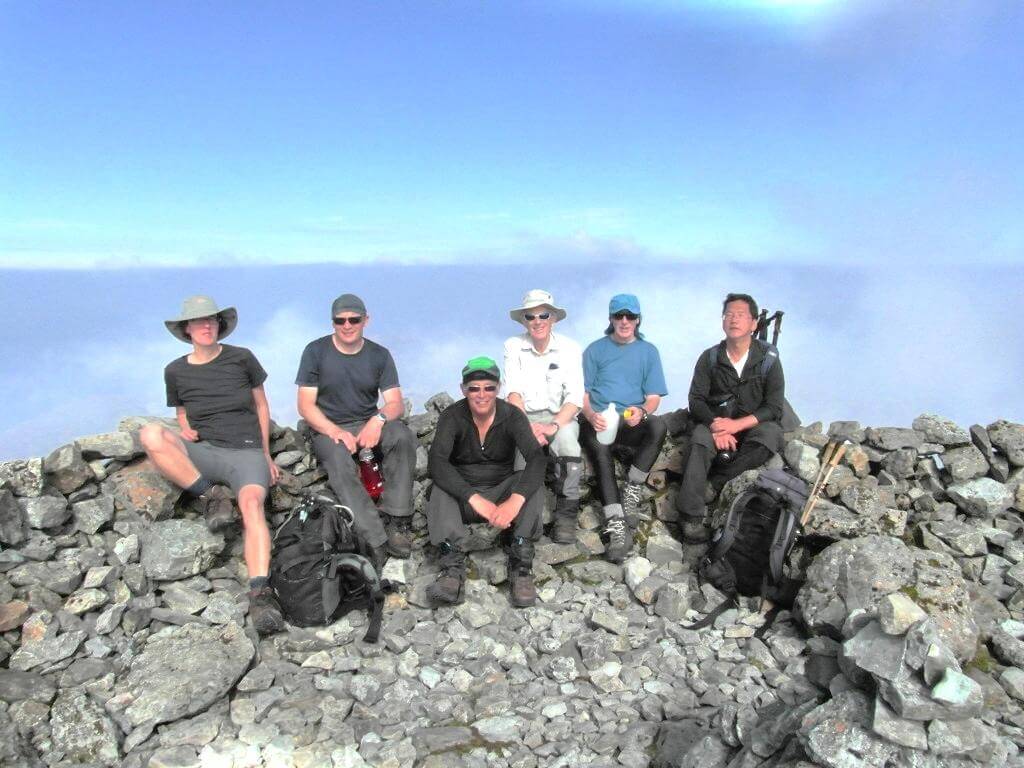
Research suggests that being in natural environments—whether green (land-based) or blue (water-based)—enhances cognitive function, memory, and creativity. It’s no surprise that spending time outdoors can lead to clearer thinking and fresh perspectives.
It may be tough at first, especially when tackling uphill climbs (I know this firsthand!), but persistence pays off. Regular walking improves endurance, strengthens muscles, and increases overall energy levels.
Sometimes, getting out of bed is an achievement in itself. But when you challenge yourself—whether it’s bagging a Munro or simply completing a scenic walk—you’ll feel a deep sense of satisfaction. That summit selfie is more than just a picture; it’s a reminder of your resilience.
Life moves fast, and it’s easy to get caught up in the rush. Taking time to step outside, breathe in the fresh air, and appreciate the natural world can be a simple yet powerful act of self-care.
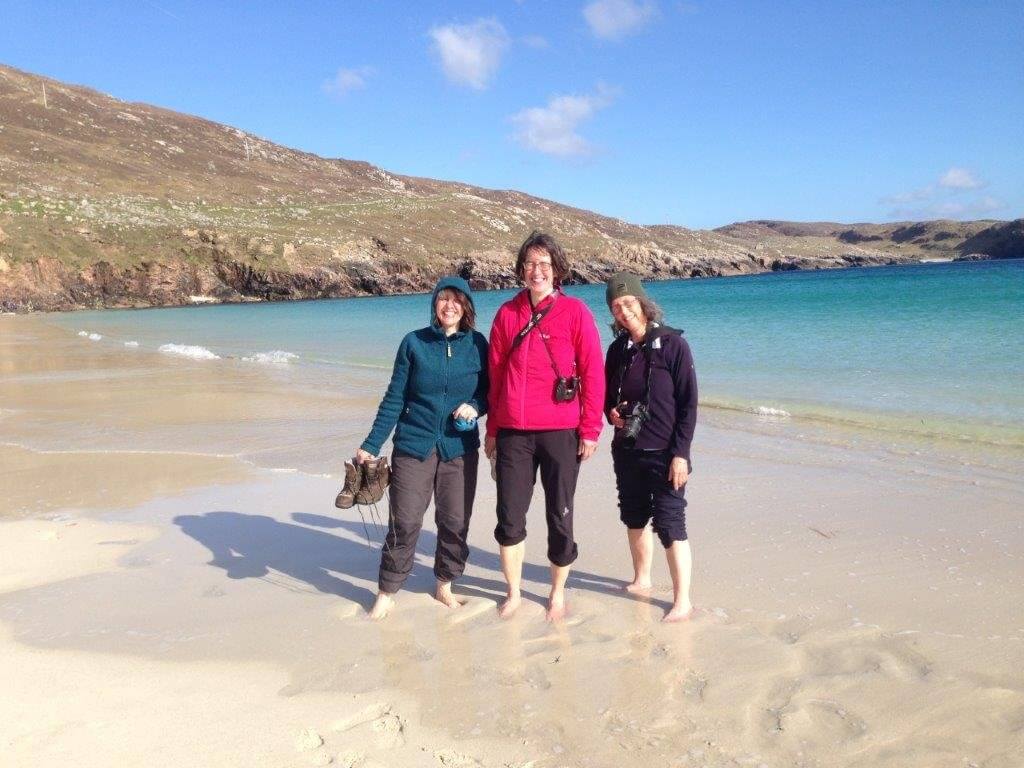
Paddling on the beach at Harris
Unlike many modern remedies for stress and fatigue, walking has no downside. It promotes better sleep, improves overall health, and is entirely free.
You don’t have to embark on an extreme expedition to reap the benefits of walking. Start small—choose a nearby trail, explore a new part of town, or plan a short walking holiday. If you need inspiration, we at Fraoch Lodge would love to help you begin your journey.
Map Travels list of 10 reasons to go on a walking holiday
https://www.forallourwellbeing.co.uk/wellbeing/walking/benefits-of-walking
Call to the wild: This is your brain on nature
Hiking in the Scottish Highlands offers numerous wellness benefits. Engaging in regular hiking can lead to significant improvements in both physical and mental health.
Physical Health Benefits
Guided walking holidays cater to all fitness levels, ensuring that every step you take strengthens your body without overwhelming it. Walking improves cardiovascular health, boosts stamina, and helps maintain joint mobility—key factors for staying vibrant and active as you age. The varied terrain of the Highlands offers gentle trails for those seeking a leisurely pace and more challenging routes for those ready to push their limits.
Regular hiking has been shown to improve cardiovascular health. A study published in the Journal of Clinical Medicine found that 12 weeks of moderate-intensity trekking decreased body weight and systolic blood pressure in elderly women who were obese, indicating enhanced heart health.
Additionally, hiking can increase bone density, reducing the risk of osteoporosis—a condition of particular concern for older adults. It also strengthens muscles and improves balance, which are crucial for maintaining mobility and preventing falls.
Mental Wellness
Spending time in nature has been proven to reduce stress and improve mood. Research indicates that walking in natural environments can lower cortisol levels by 21%, reducing feelings of stress.
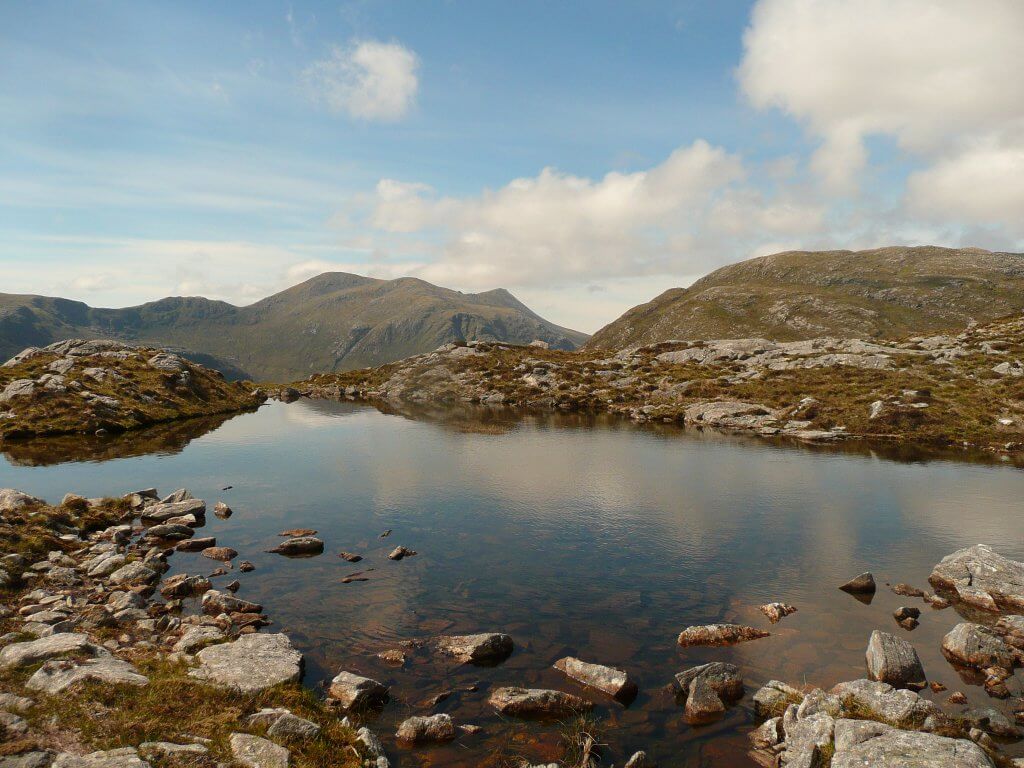
Glorious scenery on Harris only visible to those few who hike up into the wild areas.
Furthermore, hiking can decrease feelings of depression and dejection by 31.1%, contributing to overall mental well-being.
Social Connection
Participating in guided walking holidays offers opportunities to connect with like-minded individuals. Engaging in social activities during hikes can enhance psychological well-being and foster a sense of community.

Paddling on the beach at Harris
Incorporating hiking into your routine can lead to a healthier, happier you. The Scottish Highlands provide a picturesque backdrop to embark on this wellness journey.


5 Reasons to Visit the Cairngorms in Spring
Spring in the Cairngorms brings longer days, milder temperatures, and a renewed sense of life across the landscape. As the snow melts and the valleys turn green, this is one of the best times of year to experience the natural beauty of Scotland’s largest national park. Whether you’re a keen walker, wildlife enthusiast, or simply looking for a peaceful escape, here are five great reasons to visit the Cairngorms in spring.
As winter retreats, the Cairngorms become a haven for wildlife. Red squirrels, pine martens, and roe deer become more visible, while ospreys return to their nests after wintering in Africa. The hills echo with the calls of black grouse and capercaillie, making spring an exciting time for birdwatchers.
Red squirrels and mountain hare are also becoming more active. We also have beavers and wildcat which you might be able to spot if you’re lucky.
Scot Mountain Holidays offers guided trips that provide the best chances to spot these elusive species in their natural habitat.
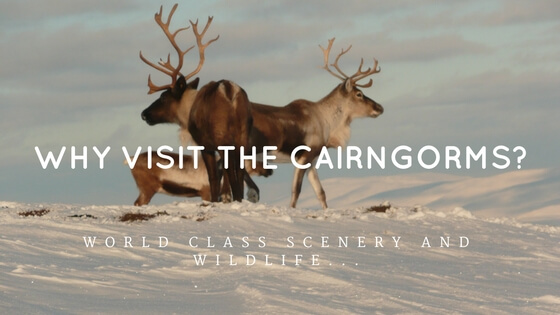
Unique wildlife and scenery plus so much more
Spring offers some of the best conditions for exploring the mountains and glens, with crisp mornings, comfortable daytime temperatures, and trails that are much quieter than in summer. Whether you prefer a gentle riverside stroll or a challenging hill walk, the Cairngorms cater to all abilities. For cycling enthusiasts, the drier trails and improved weather make it a fantastic time for both road biking and mountain biking.
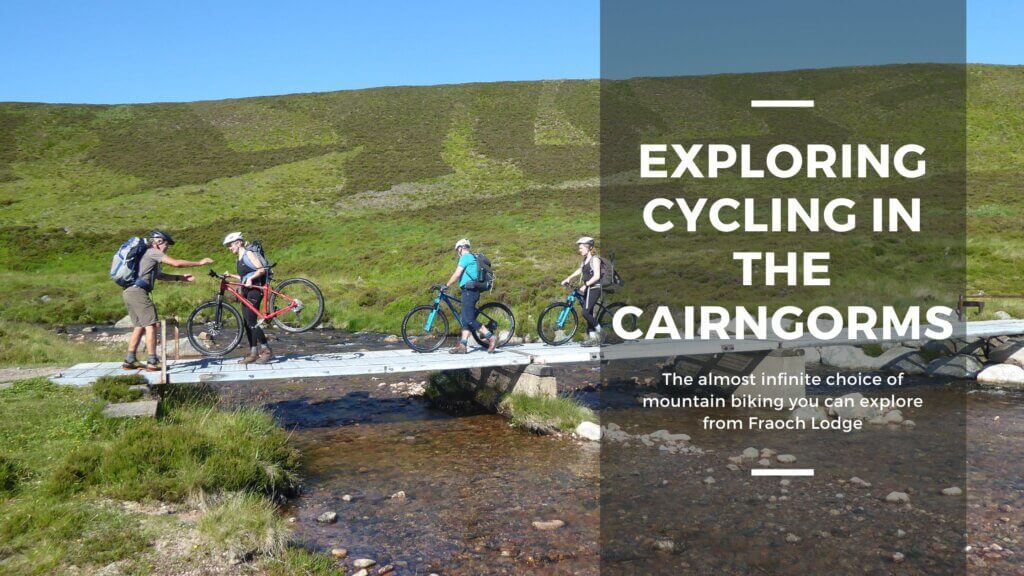
The transformation of the Cairngorms in spring is truly stunning. Heather moorlands, ancient forests, and meadows come alive with wildflowers, and fresh green leaves begin to cover the trees. It’s also one of the best times to visit the ancient Caledonian pine forests, where new life is emerging and the scent of pine fills the air.
Spring is a fantastic time to experience the Cairngorms without the summer crowds. Many of the most popular trails and viewpoints remain quiet, allowing for a more peaceful connection with nature. If you’re looking for a true escape, staying at Fraoch Lodge offers a comfortable and welcoming base to explore the area without the rush of peak season tourism.

Posing amid the grandeur of the Cairngorms scenery
Spring brings a variety of events to the Cairngorms, from walking festivals to family-friendly activities. The Ballater Walking Festival in May is a great way to explore the area with expert guidance, while events like the Highland Games taster sessions provide an insight into local traditions. There are also several cycling and trail running events for those looking for a challenge in a spectacular setting.
The Cairngorms in spring offer a unique mix of adventure, wildlife, and relaxation. Whether you want to enjoy the landscape in full bloom, take part in outdoor activities, or simply soak up the tranquillity of the Highlands, Scot Mountain Holidays and Fraoch Lodge provide the perfect base for your visit. With expert local knowledge and a warm welcome, you’ll be well-placed to make the most of this special season.

Enjoy top class family friendly and freshly prepared food.
Have you had any Easter holiday ideas yet? Thinking about the Easter holidays this year, it’s a wee bit of an awkward time – so early in the Spring season. It’s still an opportunity for some winter sports, but spring is on its way. If you’re travelling up to the Cairngorms National Park for this Easter holiday here are some ideas you might want to consider:
Experience the ultimate wild camping adventure with our exclusive hot tent camping setup, supported by Highland ponies. Hike through ancient pine forests, past serene lochs, and into breathtaking mountain landscapes. By night, enjoy the warmth of our cozy, heated tents and the luxury of hot showers—even in the heart of the wilderness! This UK-first experience is an unforgettable Easter holiday idea for families and adventure seekers alike.
👉 Book now and make Easter 2025 truly special!
Ever wondered what it’s like to sleep in a snowhole? This Easter, you can experience the thrill of a night in the Cairngorms, safely guided by Andy, Scotland’s most experienced snowhole expert. He’s built over 100 snow shelters in the past 20 years—so you’re in safe hands!
👉 Contact Andy for a private guided expedition.
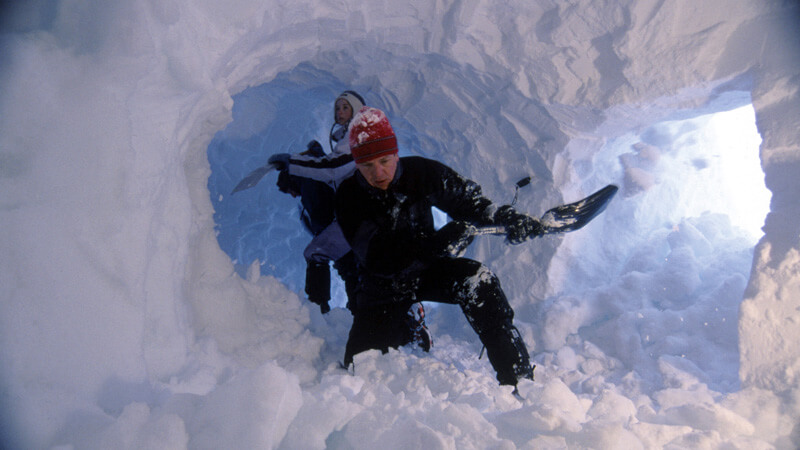
Digging in for a night out on the mountain.
Join us for a guided summit hike and discover the awe-inspiring landscapes of the Cairngorms. Whether you’re an experienced hillwalker or just looking for a safe and enjoyable mountain experience, our expert guides will tailor a walk to your level.
👉 Enquire now about guided hikes.

Posing amid the grandeur of the Cairngorms scenery
From Highland Cows and red deer to reindeer and pine martens, the Cairngorms are teeming with wildlife. For young explorers, we can organize a range of exciting experiences, including:
👉 Contact us for a tailored wildlife itinerary.
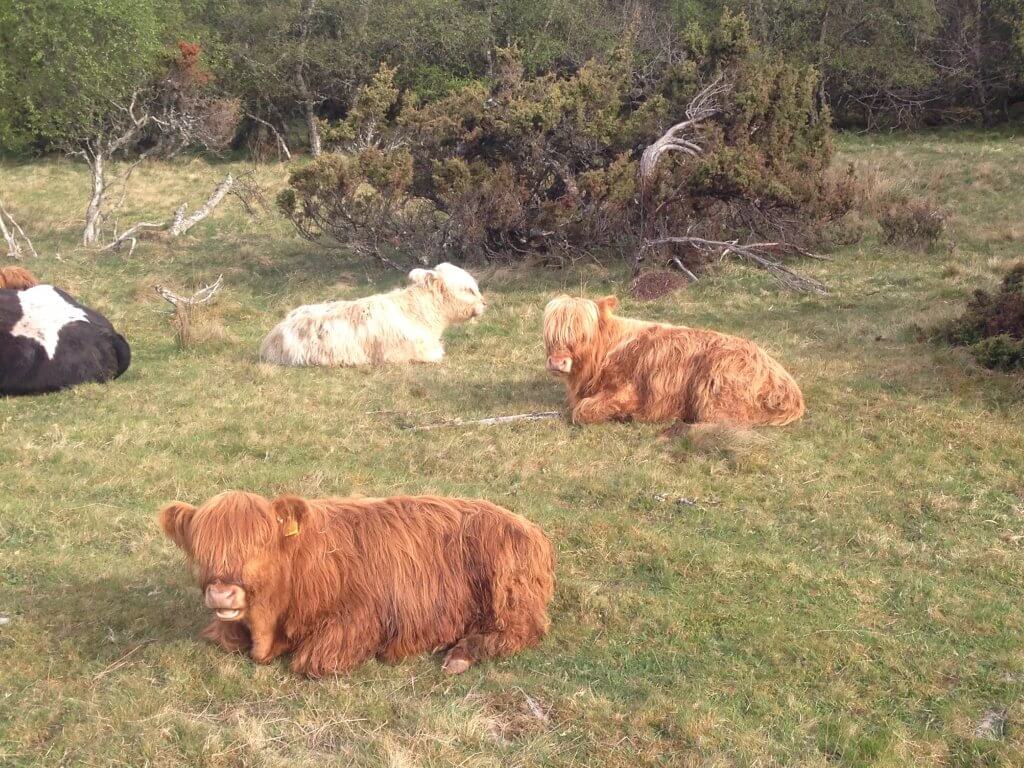
If you’re lucky you’ll pass the wee herd of Heelan Coo next to the road for a photo shoot.
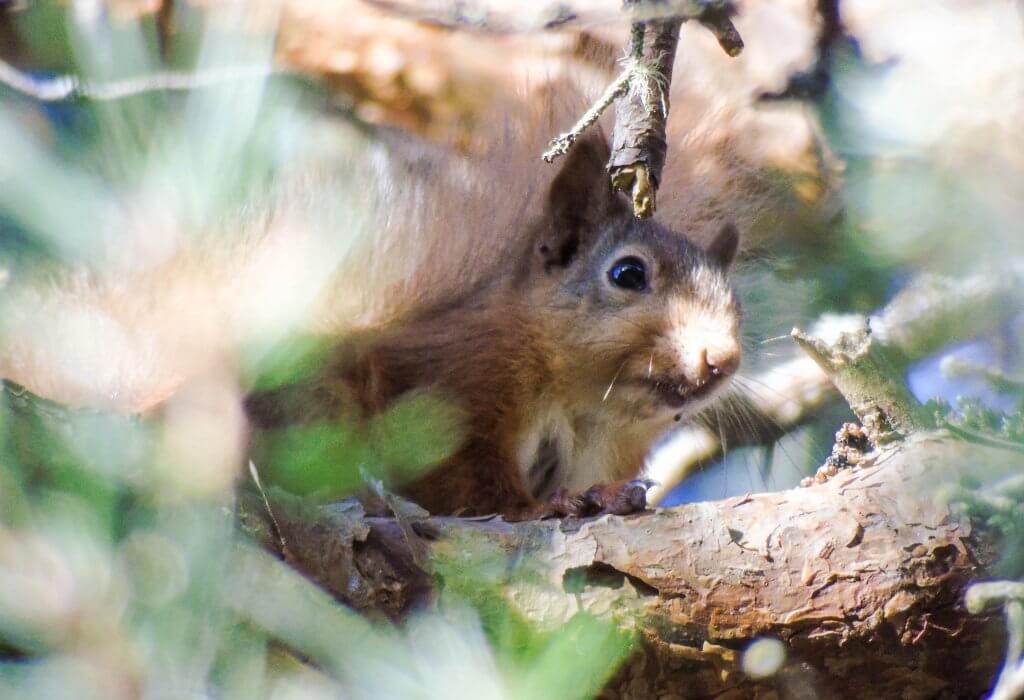
The Scottish red squirrel, photographed in the Boat of Garten woods.
No trip to Scotland is complete without sampling some of its finest whiskies! Visit the Speyside Cooperage to see the craftsmanship behind whisky casks, then explore a nearby distillery of your choice. If you’re an early riser, you might even catch a tour at Dalwhinnie Distillery! Glenfarclas Distillery or Tomintoul Distillery! Watch out for road closures around Tomintoul though in April and early May 2025.
👉 We also offer Mountains & Malts tours—ask us for details!
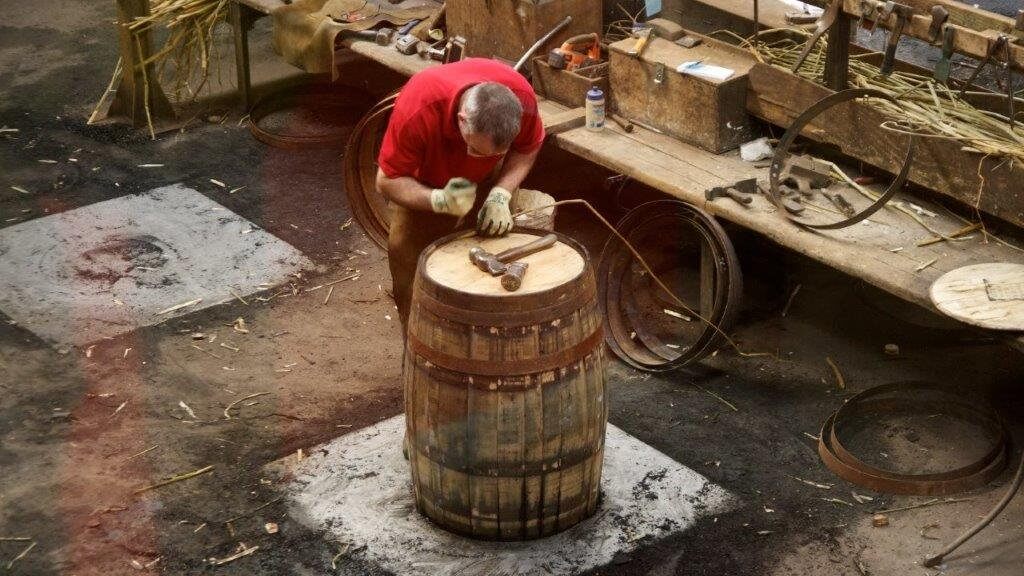
A cooper hard at work repairing casks at the Speyside Cooperage
There are a huge number of Munros accessible from Fraoch Lodge. There are Munros to climb almost from the doorstep in the Cairngorms National Park. You can also use Fraoch Lodge as your base and venture further afield. However, with Ben Macdui (2nd highest in Scotland) and Braeriach (3rd highest in Scotland), you shouldn’t need to travel far for a good workout. Do make sure you put your safety first though. This year (2018) with Easter being so early and a good covering of snow remaining, it would be a good idea to either take a local guide or make sure you have refreshed your snow skills before you venture into the hills. Contact us for a private guiding or instruction booking.
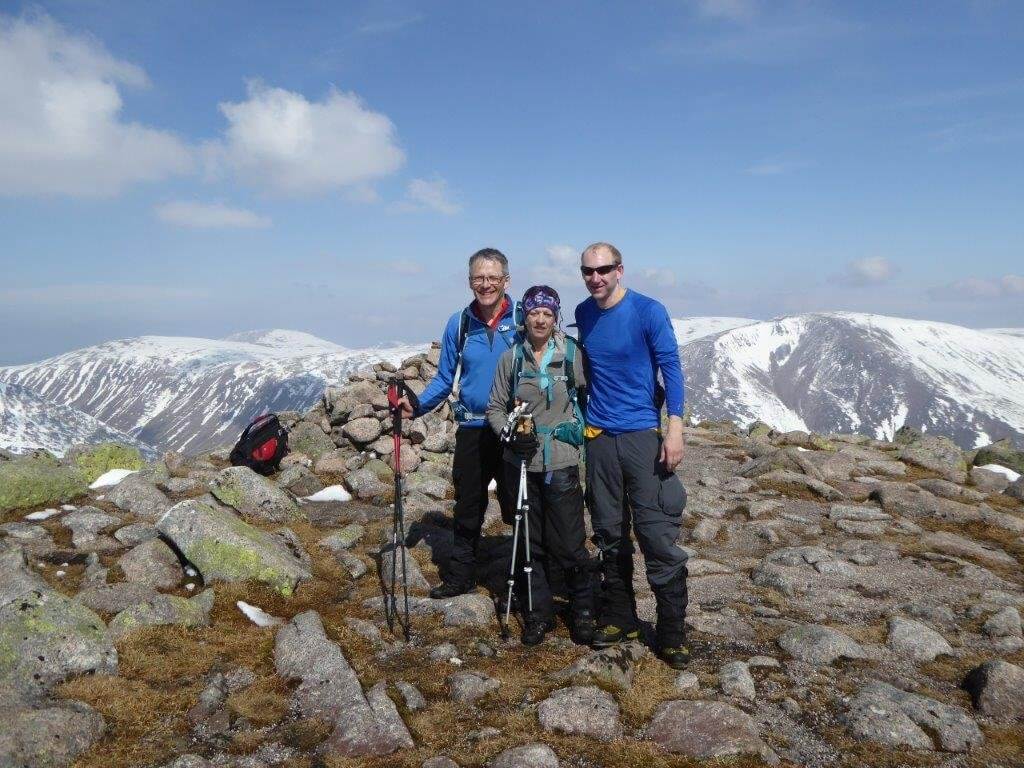
The hikers in the sunshine deep in the heart of the Cairngorms National Park (more snow than most of January). Taken April/May 2017.
Turn Easter into an adventure with geocaching or set up your own treasure hunt around the stunning Cairngorms landscape! And for a special Easter treat, our very own Rebecca is training in gourmet chocolate-making—so you could enjoy homemade chocolates straight from Fraoch Lodge!
👉 Stay with us for a delicious Easter experience!
FREE ACTIVITY
Spring may still bring chilly waters, but for the brave-hearted, Loch Morlich and Loch Insh offer fantastic opportunities for wild swimming, canoeing, and kayaking. If you’re new to wild swimming, pick up a guidebook or ask us for the best local spots!
Yes, you can still ski at Easter (some years)! The Cairngorm Mountain ski area often holds snow well into April, offering great conditions for skiing, snowboarding, and sledging. Equipment hire and lessons are available locally. Check how much skiing is available before you book. The funicular is running again but currently (04.03.25) there is extremely limited skiing on Cairngorm, no firm base and warm weather.
Get your heart racing with an exhilarating ride on the G2 Outdoor Zip Line, just outside Aviemore. Soar over the forest canopy for an unforgettable thrill—perfect for families and adventure lovers.
Make the most of Easter 2025 with a stay at Fraoch Lodge, your home away from home in the Cairngorms. Whether you want an action-packed adventure or a relaxing retreat, we’ll help you create the perfect itinerary.
📍 Book your accommodation at Fraoch Lodge now! 📩 Contact us for custom holiday packages and guided adventures.
In no particular order we’ve listed 10 of our favourite family walks in the Cairngorms. We’ve concentrated on the area we know best around the northern side of the park, but we do also know of some excellent walks on the south side of the park which we’ll mention in passing with reference to more detailed information at the end of the blog.
We’ve concentrated on walks which you can do with younger children as once your kids reach a certain age, they’re capable of achieving just as much on a day hike as any other adult.

Ascending Meall a’Bhucaille with 2 x 7 year olds and 1 x 4 year old.
Of the family walks available in the Cairngorms, this is one of the most popular, also frequented by some of the minibus tour companies like Rabbies.
The walk takes about 2 hours or 4.5 miles
It is a lovely walk to do. You don’t have to do the whole walk but the path is suitable for push chairs, particularly those with 3 wheels or larger wheel sizes.
The ruined castle on the island in the loch lends the situation a romantic aura. The area has featured in Outlander and the new Netflix extravaganza about King Arthur.
The optional extension around the neighbouring loch, is almost deserted. The path is wide and mostly through lovely open Caledonian pines. Even on a wet day, it is picturesque.
In summer, you can snack your way round on the wild bilberries which line the path in places.
Map of the route, courtesy of Walk Highlands.
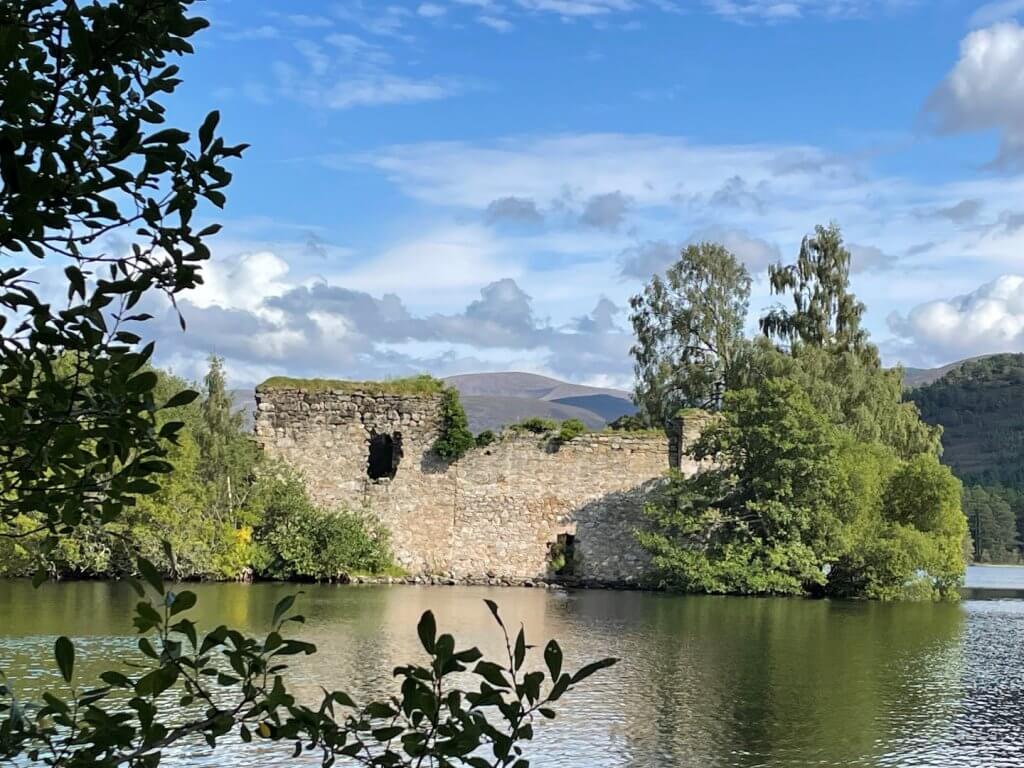
The famous castle on Loch an Eilean, Glens, Forests and Lochs
An easy walk to fit into a bigger day of activities. Going up to the Green Lochan and back to your car will only take about 1 hour.
1.2 miles: 26 mins (one way)
Start at Glenmore Lodge or the Forestry Commission Visitor Information Centre in Glenmore. Parking at the end of the road by Glenmore Lodge is limited and on a fine day you may find that there is no space there. If you are parked at the end of the road, near the visitor information centre, you will end the walk at the Cobbs cafe. A cake break here makes a fine reward at the end of the day.
The path is wide and easy to find up to the Green Lochan. It starts from the road end and continues straight up to the Green Lochan. Allow time to stop at the lochan take in the views and maybe even dabble your toes in the water. There’s a great spot for photos too.
If this is not enough of a walk for you and your family the route continues on to Ryvoan Bothy. The Bothy is a basic shelter, like a refuge. It is free to use and does not have a warden. The main thing to remember is that you should not leave anything at the bothy which wasn’t there when you arrived. You can spend the night at Ryvoan Bothy, but be prepared for some competition for the “bed” space. There is a small stove in the bothy, so providing you have fuel, you should be warm enough.
Here’s a link to the map of Walk Highland’s version of this walk which can also be done as a there and back route from your car parked outside Glenmore Lodge for a shorter route.
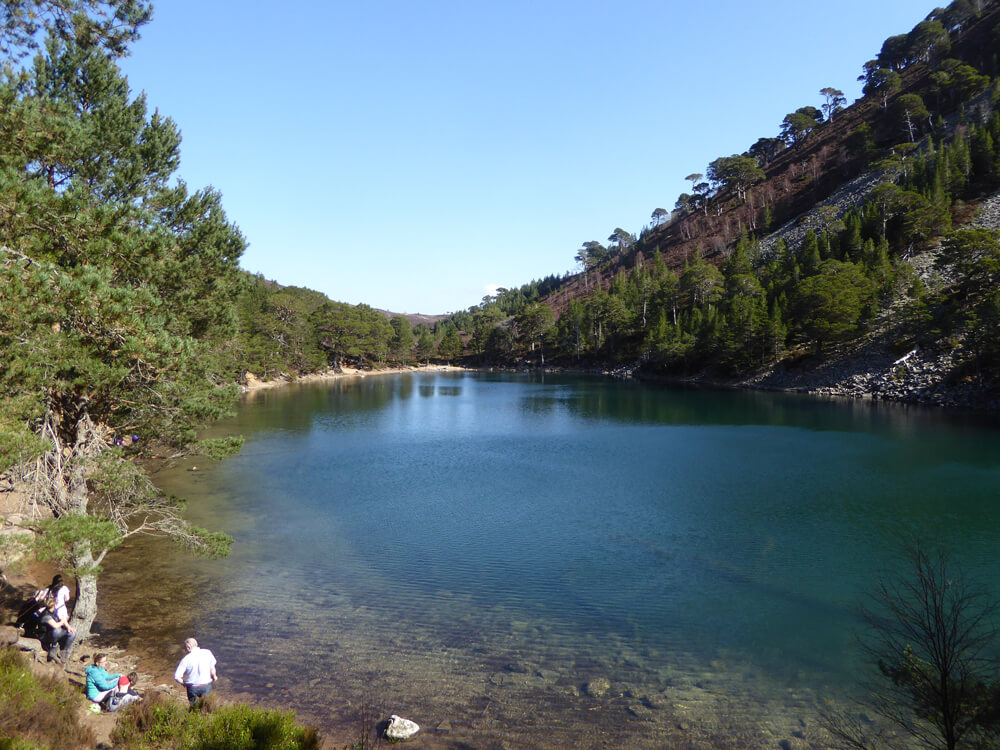
Perfect spot to rest up after a wee walk. Popular in the middle of the day.
This is a lovely walk at any time of year in almost any weather conditions. The majority of the walk is through mature Caledonian pine forest which bears no resemblance whatsoever to commercial forestry. The trees are not all straight nor are they planted in rows. The undergrowth is lush and often filled with treasures like wild blueberries, cowberries or mushrooms. You could see a red squirrel, roe deer, crested tits, ospreys etc
At Loch Garten you have the option of visiting the Osprey Hide and hearing the ongoing saga of the Osprey centre (April to August only).
Including Loch Mallachie on your circuit is a must. It is a beautiful spot and really quite peaceful. Sunrise is glorious here if you’re an early riser.
2 – 3 hours: 9km, plus walk through Boat of Garten to the car park if you are starting from Fraoch Lodge
Map courtesy of Walk Highlands
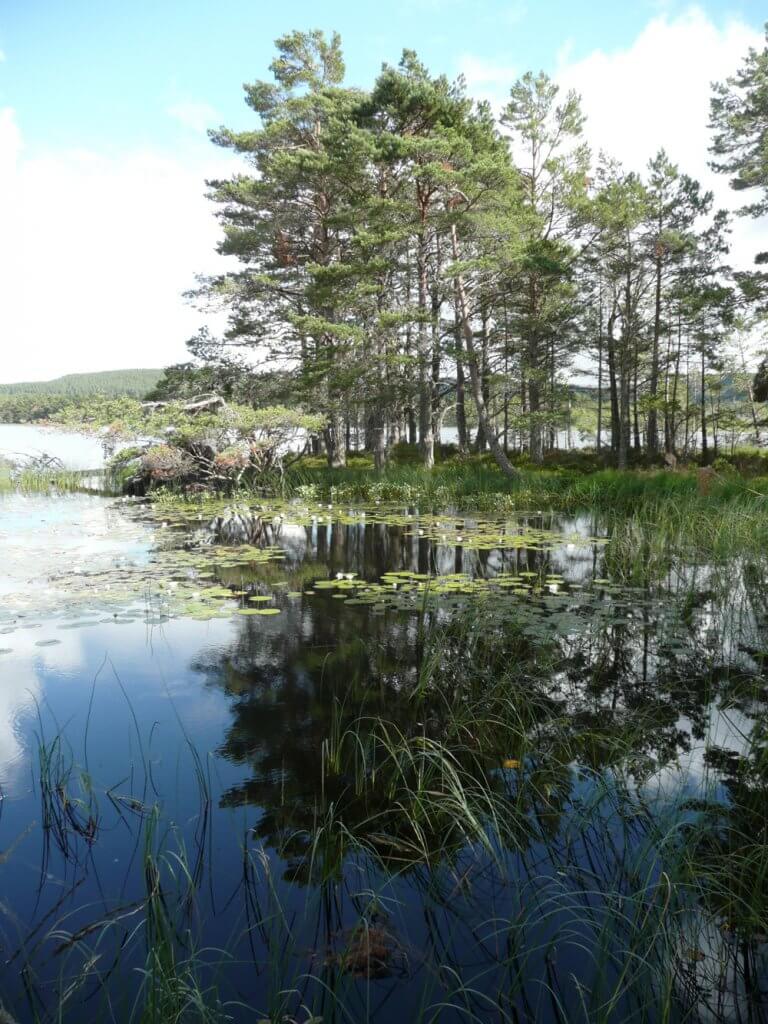
The peaceful scenery of Loch Mallachie, near Boat of Garten
This is a short way-marked circular route of 5km.
You’ll start either from the centre of Grantown, or from the caravan park (though parking is limited here). The route starts on a tarmaced track leading off left past the caravan park. You’ll then pick up signs for the Dava Way and the viewpoint walk to the right. Follow the track up the hill along the side of the stream. You’ll pass a couple of points where you can admire the view over Grantown to the Cromdale hills before reaching the ultimate viewpoint marker, atop a small rocky outcrop. Here you’ll find a viewpoint marker indicating all the mountains etc you can see.
Continue on from the viewpoint to make the walk a circular route, finishing up along the old railway track which is now part of the Dava Way.
There are opportunities to Geocache along the way if you feel the need to add a bit of interest to the walk.
For a full route description try Walk Highlands
This is a really short walk suitable for even the youngest members of the family. It follows the river Nethy from the bridge in the centre of Nethybridge up towards the Dell of Abernethy. There are also plenty of opportunities to extend the walk along the local network of paths, the majority of which are waymarked.
You can also pick up a map at the information centre in the village hall right at the start of your walk.
There are alternative routes out to Broomhill station and Castle Roy on the other side of Nethybridge.
Take the steam train from Boat of Garten to Broomhill. Follow the walking route into Nethybridge and either pick you way to the river where there is a wee beach where you can relax. You can paddle in the shallows too. But watch out, because there are deeper patches in the middle of the river. Don’t try to wade out to the other side.
From here you could also pick up the Speyside way and walk all the way back to Boat of Garten which is no more than 5 miles and probably less. It’s a great walk with plenty of opportunities in the summer to stop and snack on bilberries (wild blueberries).
There are plenty of Geocache possibilities in Nethybridge too to keep the kids focused.
Ellan Woods are again filled with Geocache boxes. Even if you don’t travel that far, the kids will have a great time trying to retrieve as many prizes as they can.
Parts of the off-road route 7 cycle path also pass through Carrbridge.
If you’re looking for a longer alternative, we do include a Carrbridge circuit in our self-guided Cairngorm itinerary. You could also take a look at the week long itinerary of self-guided walks: we could adapt this trip for your group.
Sluggan bridge as a walk on it’s own is suitable for almost anyone to do. It is just a quick stretch of the legs, but can easily be extended and is such as lovely spot that you can easily spend an afternoon there with the kids. Dabble in the water and have a picnic.
This is a wee favourite of ours. A little jaunt up to a viewpoint above Aviemore, or if you have really wee ones just go to the wee lochans. You’d hardly know you’re right next to the A9.
The walk is about 5km so probably not one for really young ones. Parts of it were a wee bit icy when we did it (admittedly that was March and really only to be expected). Lovely walk which breaks out of the birch forest to provide spectacular views as below. Some steep sections but easily managed by anyone of moderate fitness. Walking poles advised if you are not used to hill walking.
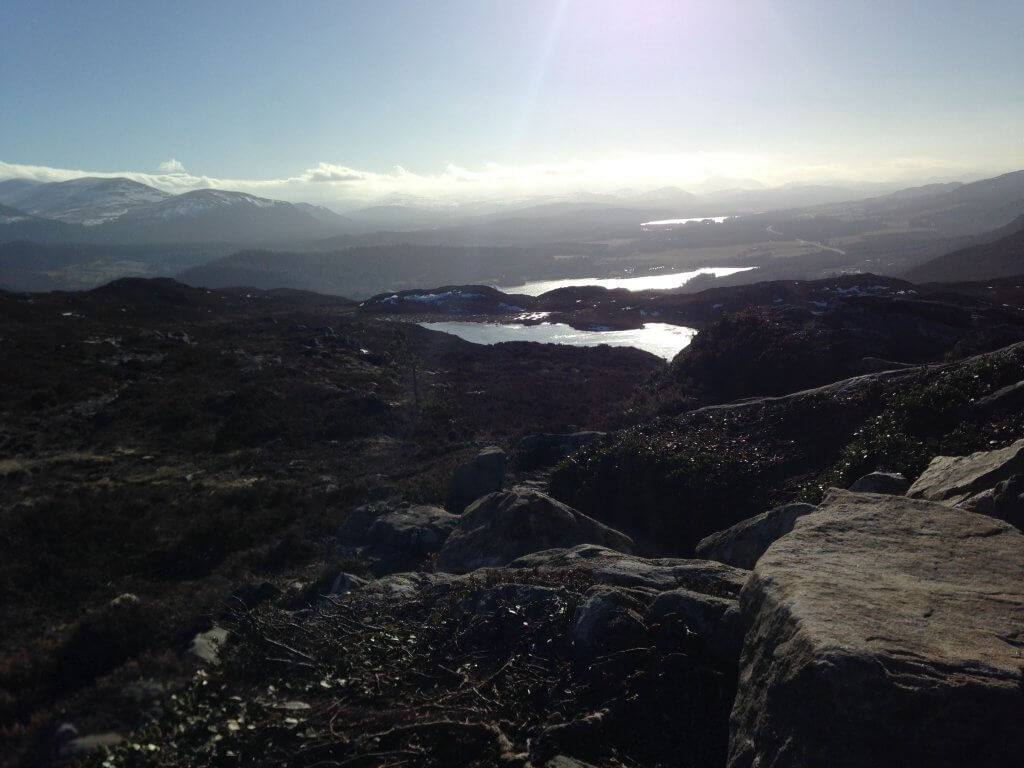
Spectacular and unusual views from the viewpoint above Craigellachie Nature Reserve
Well worth a wee gander across the moor to Aviemore. You follow the route of the Strathspey Railway most of the way to Aviemore as well as the course of the river Spey. This is part of the Speyside Way. It is a well maintained wide path. You’ll be heading towards the Cairngorms so spectacular views of the mountains. The only downside is that there is very little shelter for the majority of the route though the beginning and the end are protected by trees.
Points of interest:
You can come out into Aviemore on the Dalfaber estate, right next to Cairngorm Brewery. Worth a stop? They do brewery tours! Also near here: Kilted Fudge (for the kids to pick up a treat) and Route 7 Cafe.
You can return by steam train to Boat of Garten if you time it right, or alternatively take the public bus service (no. 34) back to the village.
5 to 6 miles, depending on how far into Aviemore you go.
We’ve already covered this option in some detail in a previous blog. Do click on the link for full details. This is a very popular family walk. Plenty of treats for the younger kids to encourage them to the top.
This is quite a walk for wee kids, but don’t forget if it’s your first attempt and the kids get tired, you usually have the option of taking the funicular train back down (providing you remember your wallet).
Again it is easy to extend this walk if you want or keep it short and just pop in at the Ptarmigan restaurant at the top for snacks and refreshments.
Do not attempt this walk with young kids in the winter months.
From the ski car park to the summit is: just over 4km, 2 – 2.5 hr walking
Remember: there is no shelter or shade on this walk. Cairngorm is sub-arctic tundra. Most of the vegetation is less than knee high. There are trees but they are of the dwarf variety and don’t even reach you knees. You’d have to know what you’re looking at to identify them as trees!

A family day out on the summit of Cairngorm (with diversions to hunt for snow)
For maps and full route descriptions try WalkHighlands
For leaflets on the community trails around many of the villages in the Cairngorms click here
Visit Scotland’s suggestions for scenic family walks
Best hikes in the Cairngorms from the Guardian.
https://blog.visitcairngorms.com/six-great-walks-beginners-families/
How to Stay Safe in the Scottish Winter Mountains: Essential Tips for Hiking and Climbing
Scotland’s winter hills offer unparalleled beauty and adventure, but venturing into this environment requires preparation and caution. The #ThinkWINTER campaign by the Mountaineering Council of Scotland aims to raise awareness about safety in winter conditions, offering practical advice to keep adventurers safe. With over 1,000 mountain rescues occurring annually across the UK, preparedness is crucial. Here’s how to ensure your trip is both enjoyable and safe.
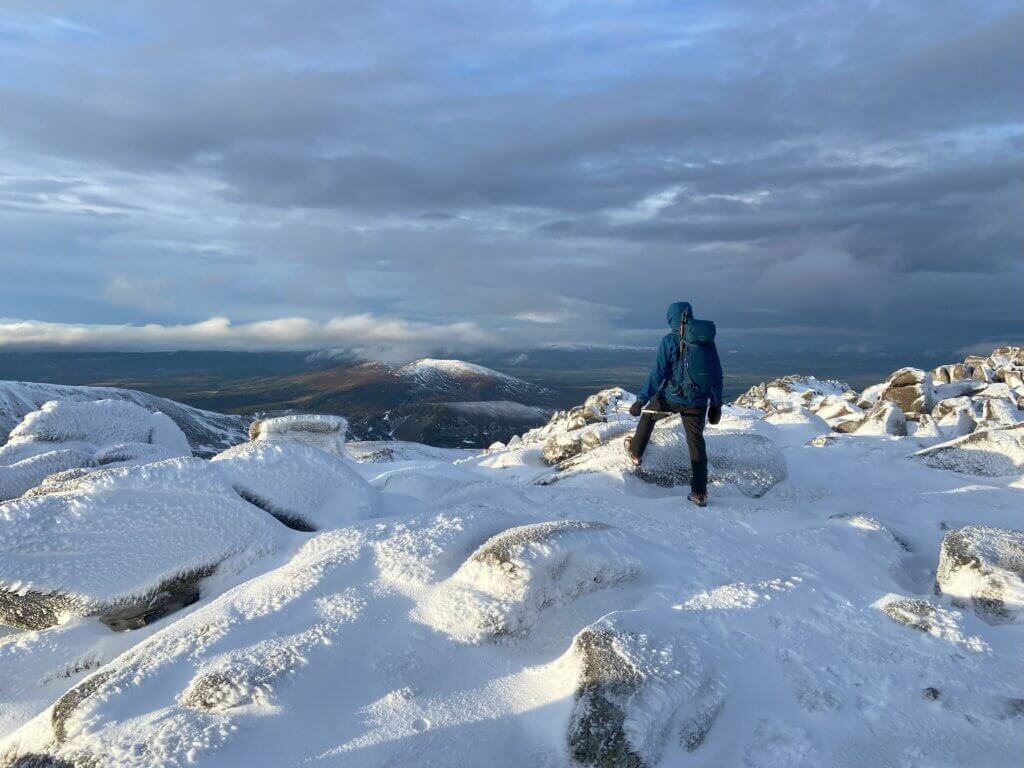
1. Comprehensive Planning
2. Weather and Avalanche Awareness
3. Clothing and Equipment
4. Skill Development

Test your limits, within your means
For those uncertain about navigating Scotland’s winter hills, guided trips provide a safe alternative. Scot Mountain Holidays offers guided hiking and climbing adventures, alongside accommodation, transport, and full catering. With their expert knowledge, you’ll experience the beauty of the Scottish Highlands safely and comfortably.
The #ThinkWINTER campaign encourages hikers and climbers to:
By adopting these practices, you can reduce your risk and enjoy your adventure responsibly. Remember, mountain safety isn’t just about you—it ensures rescue teams, often volunteers, aren’t unnecessarily called into dangerous situations.
Prepare wisely, respect the mountains, and embrace Scotland’s winter magic with confidence!
5 Reasons to Visit the Cairngorms in Winter
The Cairngorms in winter offer a completely different experience from the rest of the UK. Snow-covered peaks, quiet trails, and crisp mountain air make it an ideal destination for those looking to explore Scotland’s wild landscapes in the colder months. Whether you’re keen on winter walking, improving your mountain skills, or simply enjoying the peace and beauty of the Highlands, the Cairngorms have plenty to offer. Here are five reasons to visit:
The Cairngorms contain Britain’s highest and most extensive mountain plateau, giving them some of the most reliable winter conditions in the UK. Snow lingers well into spring, creating an environment more akin to Scandinavia than anywhere else in Britain. With Scot Mountain Holidays, you can explore this unique winter landscape safely, whether on foot, or even cross-country skis.
The Cairngorms offer some of the best winter walking and mountaineering in the UK. Unlike other mountain ranges, their vast, high-altitude terrain provides a real winter experience, with deep snow and ice often lasting for months. Whether you’re looking for a straightforward hill walk or something more technical, Scot Mountain Holidays can guide you through the best routes while ensuring you stay safe and build confidence in winter conditions.
It can be dangerous to get out into the hills in winter so it is highly recommended to take advantage of the plethora of local guides. You don’t want to be the reason the mountain rescue team are called out.
The Cairngorms are the top destination in the UK for learning winter mountain skills. With consistently snowy conditions and a variety of terrain, it’s the perfect place to learn how to use an ice axe, crampons, and navigate safely in winter. At Fraoch Lodge, we run winter skills courses to help hillwalkers and climbers develop the knowledge and confidence they need to enjoy the mountains in all conditions.
Learning the technical skills for both safe movement in the winter hills and whiteout navigation will eventually allow you go be independent in winter.
Winter in the Cairngorms offers some of the best wildlife watching opportunities in the UK. With the snow-covered landscape acting as a blank canvas, it’s much easier to spot elusive species like mountain hares, ptarmigan, red deer, and even golden eagles. Unlike more accessible national parks, the Cairngorms provide a real sense of remoteness, making wildlife encounters all the more special.
We can arrange winter wildlife trips for you or you can stay at Fraoch Lodge and arrange your own guide. We recommend either Speyside Wildlife or Malcolm at Arc Guiding. Malcolm is also a ski and mountain bike guide.
After a day exploring the wintery landscapes, there’s nothing better than returning to a warm, welcoming retreat. The Cairngorms offer a range of cosy accommodation, from traditional lodges to charming B&Bs & hostels. At Fraoch Lodge, we provide hearty home-cooked meals, a roaring fire, and a friendly atmosphere—perfect for unwinding and sharing stories of the day’s adventures. We also have a purpose built drying room for all your outdoor gear, complete with bar heaters (for a gentle heat under your boots) and a dehumidifier (to get rid of all that excess moisture).
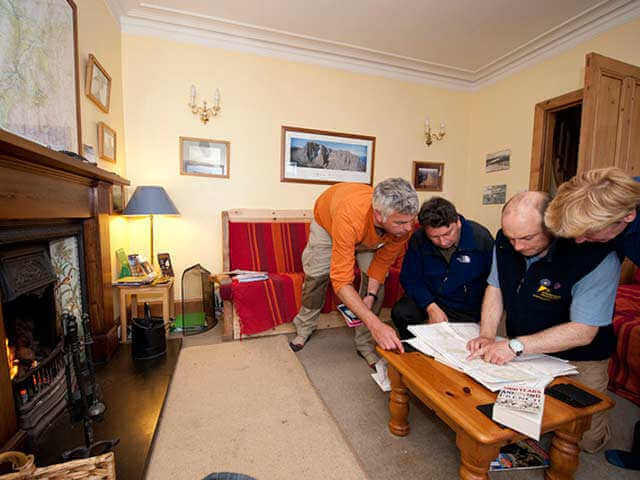
Enjoy the open fire and discussions in the lounge
Winter in the Cairngorms is a truly special experience, offering adventure, tranquillity, and the chance to connect with nature in its most magical season. Whether you’re keen to develop your skills, explore new landscapes, or simply soak up the beauty of Scotland in winter, there’s no better time to visit. If you’re looking for a guided experience or a welcoming base, Scot Mountain Holidays and Fraoch Lodge are here to help you make the most of your winter adventure.
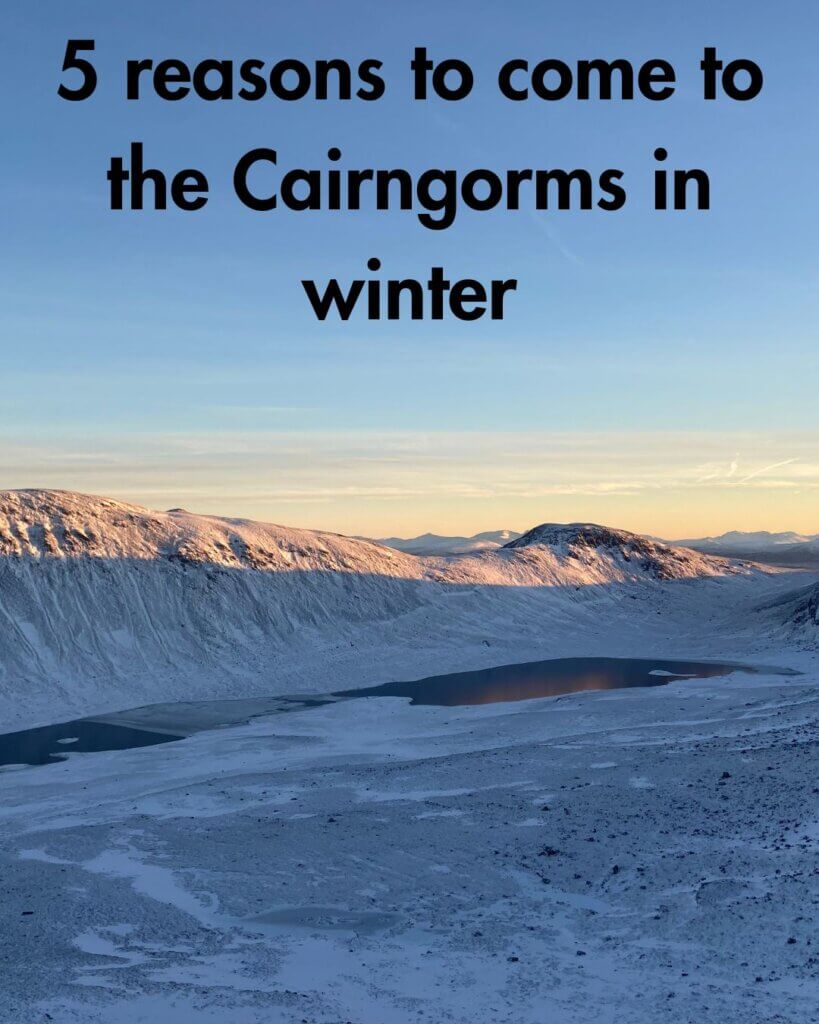
One of the most frequently asked questions from those joining our winter courses is: What if there is no snow? Although we can’t control the weather, we can almost guarantee there will be snow—especially on the high peaks during winter and early spring. However, for those still concerned, let us put your worries to rest.
The Cairngorms are home to Britain’s most permanent snow beds, some of which persist well into July or even early August. The high altitude and vast plateau of the Cairngorms make them a natural snow trap. Even in milder winters, the unique topography and wind patterns often ensure that snow is captured and retained in key areas. According to a study by the Royal Meteorological Society, the Cairngorm plateau experiences snow coverage for an average of 76 days per year, making it one of the most reliable locations for snow in the UK.
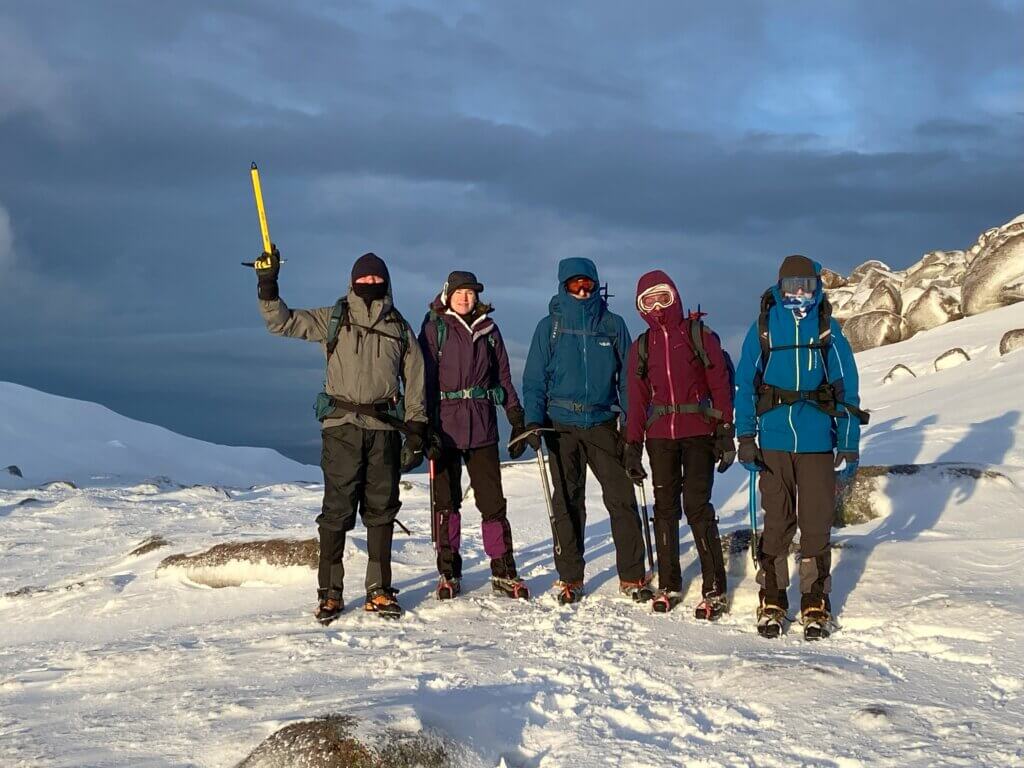
If, for some reason, the winter is unusually mild and snowfall is limited, it’s not the end of the world. Winter Skill courses with Scot Mountain Holidays are designed with flexibility in mind. Snow is just one of three critical factors that influence the course—the other two being wind (which facilitates snow drifting) and the expansive Cairngorm plateau (which helps to capture and hold snow).
Even if snow levels are lower, the skills taught during our courses remain relevant. In fact, hard, icy snow that forms after a thaw and subsequent freeze is often ideal for teaching crampon techniques. Fresh snow, while beautiful, doesn’t always add additional value to winter skills training.
In the 25 winter seasons that Scot Mountain Holidays has been running Winter Skills courses and hiking holidays, no course has ever been cancelled due to a lack of snow. This incredible track record highlights the reliability of the Cairngorms as a winter training destination.
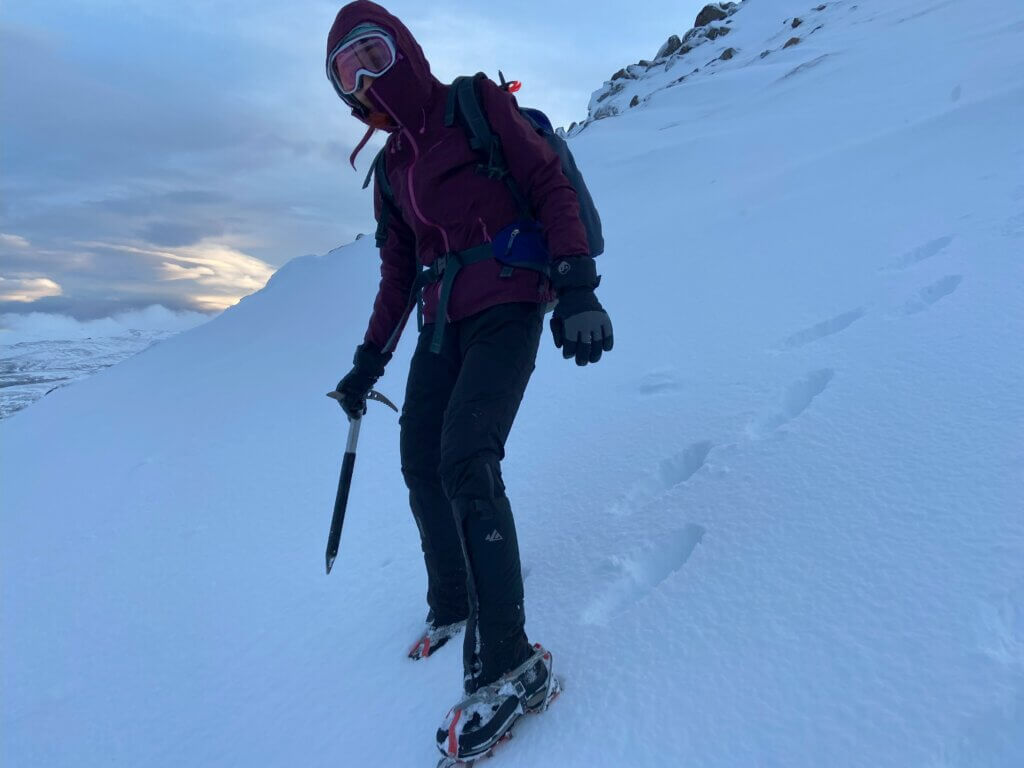
While snow is a strong likelihood on the peaks where our courses take place, there are many other elements that make your experience memorable. Thick, deep snow can sometimes make routes more strenuous. On the other hand, mixed conditions offer a chance to practice a wide variety of essential skills, including:
These skills are just as important, if not more so, than simply walking on deep snow.
Remember, winter skills are about preparing you for all types of conditions you might encounter in the mountains. Snow is a bonus, but not a requirement. The camaraderie, expert instruction, and opportunity to immerse yourself in Scotland’s stunning winter landscape are what truly make Scot Mountain Holidays’ courses unforgettable.
So, whether the snow is thick, patchy, or concentrated in specific areas, rest assured that your Winter Skills course will still be an incredible and valuable experience. The Cairngorms’ rugged beauty, combined with expert guidance, ensures your time with us is both safe and rewarding. As one participant noted, “The course was transformational—I learned so much, regardless of snow levels.”
Join us this winter to develop your confidence and skills in one of the UK’s most dramatic settings. With Scot Mountain Holidays, you’re in expert hands, and no matter the snow conditions, we’ll make sure your time in the Cairngorms is unforgettable.
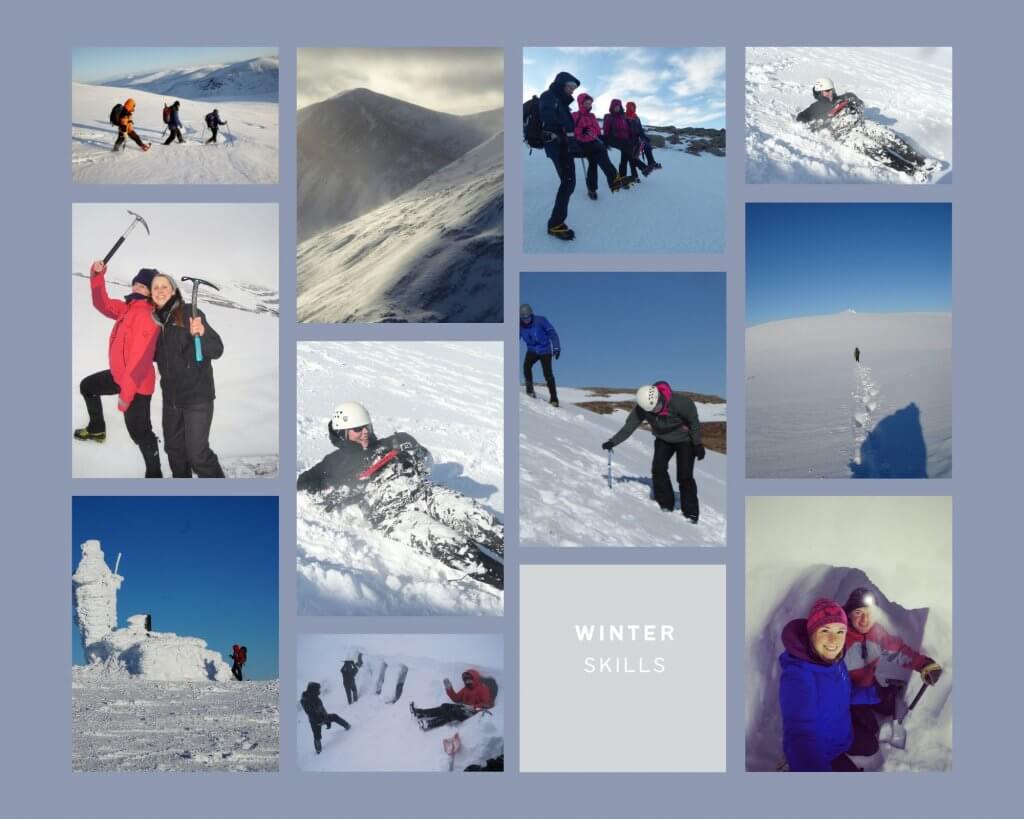
All content © Copyright Scot Mountain Holidays 2025
Responsive web design by Summit Web Solutions